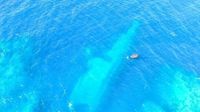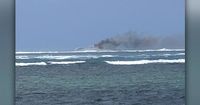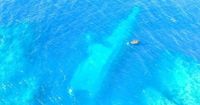On October 6, 2025, the government of New Zealand agreed to pay 10 million Samoan tala—approximately $3.5 million USD—in compensation to Samoa, marking a significant chapter in the aftermath of the HMNZS Manawanui disaster. The payment, which New Zealand’s Foreign Minister Winston Peters described as a gesture made "in full and with good faith," follows a tumultuous year for both nations after the specialist navy vessel ran aground and sank off the coast of Upolu, Samoa’s second largest island.
The incident occurred on the night of October 5, 2024, when the HMNZS Manawanui, a dive and hydrographic ship in service since 2019, struck a reef about 1.6 kilometers from shore during a routine survey. Within hours, the vessel caught fire and ultimately sank, leaving its wreck still resting on the reef a year later. Miraculously, all 75 crew members and passengers were safely evacuated—an outcome many credit to the decisive action of Commander Yvonne Gray, a veteran with 30 years of naval experience. As the ship listed and fire threatened to spread, Gray gave the order to abandon ship, a move praised by New Zealand’s Chief of Navy, Rear Admiral Garin Golding, as the "right decision" that "saved lives."
But the story of the Manawanui’s sinking is not just one of maritime misfortune—it is also a tale of human error, institutional shortcomings, and the ripple effects felt by communities and ecosystems. According to a comprehensive Court of Inquiry published in April 2025, the disaster was precipitated by a "series of human errors," compounded by "inadequate training, limited experience, and poor supervision." The inquiry revealed that the ship’s crew failed to realize the vessel was on autopilot as it plowed toward the reef, mistakenly believing another system had malfunctioned. The report also highlighted a culture that sometimes prioritized mission accomplishment over safety, with deficiencies in ship qualifications and platform endorsements among key personnel. "These deficiencies and lack of training and experience collectively combined to contribute to the ship grounding," the report stated, as cited by 1News.
While the vessel itself was found to be mechanically sound, the inquiry’s findings prompted a flurry of recommendations, which New Zealand’s military says are now being implemented. Disciplinary proceedings for those involved remain pending, with the Defence Force investigation "reaching its closing stages," according to statements from Peters’ office.
The environmental consequences of the sinking were immediate and severe. Hundreds of thousands of liters of diesel fuel leaked from the Manawanui, dispersing debris and pollutants into the surrounding water. Local fishermen and tourism operators on Upolu’s south coast were hit hard, with fishing warnings issued due to elevated hydrocarbon levels. The New Zealand Defence Force (NZDF), working with Samoan authorities, undertook extensive efforts over the past year to mitigate these impacts. Fallen shipping containers, fuel, oil, weapons, ammunition, and other debris were painstakingly removed from the wreck site. By February 2025, monitoring by the Scientific Research Organisation of Samoa showed the seawater was "clear and uncontaminated from elevated hydrocarbons," leading to the full lifting of fishing bans. "One year on, we recognise the impact that the sinking has had on the people of Samoa, particularly the communities of the south coast," said Captain Rodger Ward of the NZDF.
Still, the future of the wreck remains uncertain. New Zealand officials continue to collaborate with their Samoan counterparts on decisions regarding whether the Manawanui will stay where it lies or be removed. As NZDF response lead Andrew Brown explained, "That work includes progressing an independent wreck assessment together with environmental studies. This information will be essential in supporting decisions about the future work required." The priorities, according to Peters, remain "minimising any possible environmental impacts and supporting the response."
The compensation package, drawn from New Zealand’s military funds, was the full amount requested by the Samoan government. Peters emphasized, "We have always said we will do the right thing." The payment is intended to help offset the disruption and damage caused to Samoan communities, fisheries, and businesses dependent on a healthy marine environment. Samoa’s government, for its part, has been presented with a range of options regarding the wreck, as Prime Minister Fiame Naomi Mata’afa told 1News, but has yet to issue a formal response to the compensation announcement.
The Manawanui disaster also sparked a heated public debate in New Zealand, particularly regarding the role of Commander Yvonne Gray. Social media was awash with sexist and homophobic commentary targeting Gray’s gender and sexuality, prompting a sharp rebuke from Defence Minister Judith Collins. "The one thing that we already know did not cause it is the gender of the ship's captain, a woman with 30 years of naval experience who made the call to get her people to safety," Collins said, calling out the "deeply concerning misogynist narrative" that emerged online. She added, "I'm appalled to see the comments online from these armchair admirals, people who will never have to make decisions which mean life or death for their subordinates."
Despite the controversy, Gray’s leadership during the crisis has been widely praised within the military. The Manawanui was the first New Zealand navy vessel lost at sea since World War II—a fact that underscores the rarity and gravity of the incident. As the Defence Force and government work to implement the lessons learned, there is a renewed focus on training, supervision, and a safety-first culture within the Royal New Zealand Navy.
International cooperation has also been a feature of the response, with New Zealand thanking the United Kingdom and HMS Tamar for assisting in recovery efforts. This spirit of collaboration is evident in the ongoing joint work between New Zealand and Samoa to address the environmental and social ramifications of the disaster.
For the people of Samoa, the compensation marks a step toward closure, though the scars on the reef and in local livelihoods may linger for years. For New Zealand, it is a moment of reckoning—a reminder of the responsibilities that come with operating in the Pacific and the importance of humility, accountability, and partnership in the face of adversity.






